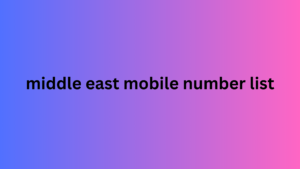In the ever-evolving world of SEO, optimizing for long-tail keywords has become a vital strategy for driving targeted traffic. One crucial aspect of this approach is the use of anchor text. By strategically incorporating anchor text for long-tail keywords a comprehensive guide, you can enhance your site’s relevance and visibility. This guide delves into the essentials of using anchor text effectively to boost your SEO efforts.
1. What Are Long-Tail Keywords and Why Do They Matter?
Long-tail keywords are longer, more specific phrases that target niche audiences. Unlike short, broad keywords, they cater to users with precise search intents. For example middle east mobile number list, instead of targeting “digital marketing,” a long-tail keyword might be “affordable digital marketing services for small businesses.”
These keywords matter because they face less competition, attract highly relevant traffic, and often result in better conversion rates. Users searching with long-tail keywords are typically closer to making decisions a comprehensive guide, making them valuable prospects.
2. Understanding Anchor Text
Anchor text refers to the clickable words in a hyperlink. It serves two primary purposes:
- Guiding users to relevant pages.
- Signaling search engines about the linked content’s context.
For example, in the phrase “Learn more about SEO strategies,” the words “SEO strategies” serve as the anchor text. When optimized for long-tail keywords how anchor text helps your site rank higher for long-tail keywords, anchor text becomes a powerful SEO tool to enhance a page’s relevance for specific search queries.
3. Best Practices for Using Anchor Text with Long-Tail Keywords
A. Keep it Natural
While it’s tempting to stuff exact-match keywords into anchor text, doing so can lead to penalties from search engines. Instead, aim for natural integration. For instance a comprehensive guide, use phrases like “Discover the best content marketing tips for startups” rather than awkwardly forcing keywords.
B. Diversify Anchor Text Types
To create a balanced link profile, use a mix of:
- Exact-match: The anchor text exactly matches the targeted long-tail keyword.
- Partial-match: Includes variations of the long-tail keyword.
- Branded: Incorporates your brand name with keywords.
- Generic: Phrases like “click here” or “learn more.”
C. Context Matters
Ensure the anchor text fits seamlessly into the surrounding content. For example de cell number, in an article about SEO tools a comprehensive guide, a relevant anchor text could be “explore effective on-page SEO tools for beginners.”
D. Link to High-Quality Pages
Anchor text should link to pages that provide value. Whether it’s your blog, product page, or an authoritative external source, the linked content must enhance the user experience.
4. The Impact of Optimized Anchor Text
Using optimized anchor text for long-tail keywords can significantly improve your site’s SEO. Here’s how:
- Improved Ranking: Search engines prioritize pages with relevant links.
- Higher Engagement: Relevant anchor text attracts clicks from interested users.
- Better User Experience: Properly contextual links make navigation seamless.
Additionally, long-tail keyword optimization helps capture a broader audience by targeting specific queries, leading to higher conversions and reduced bounce rates.

